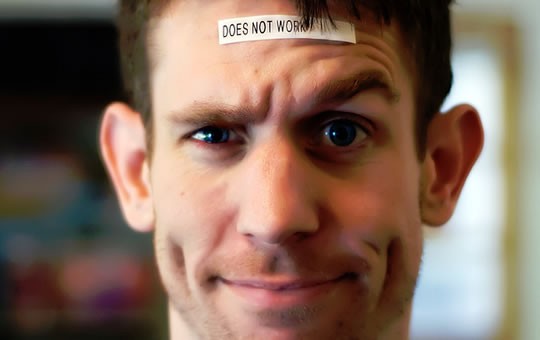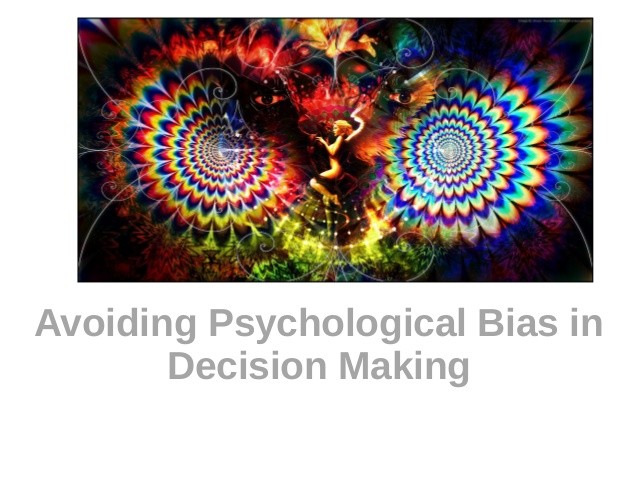Avoiding Psychological Bias in Decision Making From
Post on: 16 Март, 2015 No Comment

in Decision Making
How to Make Objective Decisions
Psychological bias can lead you to make a wrong decision.
iStockphoto/VicZA
Imagine that you’re researching a potential product. You think that the market is growing, and, as part of your research, you find information that supports this belief.
As a result, you decide that the product will do well, and you launch it, backed by a major marketing campaign.
However, the product fails. The market hasn’t expanded, so there are fewer customers than you expected. You can’t sell enough of your products to cover their costs, and you make a loss.
In this scenario, your decision was affected by confirmation bias. With this, you interpret market information in a way that confirms your preconceptions instead of seeing it objectively and you make wrong decisions as a result.
Confirmation bias is one of many psychological biases to which we’re all susceptible when we make decisions. In this article, we’ll look at common types of bias, and we’ll outline what you can do to avoid them.
What is Psychological Bias?
Psychologists Daniel Kahneman, Paul Slovic, and Amos Tversky introduced the concept of psychological bias in the early 1970s. They published their findings in their 1982 book, Judgment Under Uncertainty .
They explained that psychological bias also known as cognitive bias is the tendency to make decisions or take action in an illogical way. For example, you might subconsciously make selective use of data, or you might feel pressured to make a decision by powerful colleagues.
Psychological bias is the opposite of common sense and clear, measured judgment. It can lead to missed opportunities and poor decision making.
Common Psychological Biases
Below, we outline five psychological biases that are common in business decision making. We also look at how you can overcome them, and thereby make better decisions.
1. Confirmation Bias
As we showed above, confirmation bias happens when you look for information that supports your existing beliefs, and reject data that go against what you believe. This can lead you to make biased decisions, because you don’t factor in all of the relevant information.
A 2013 study found that confirmation bias can affect the way that people view statistics. Its authors report that people have a tendency to infer information from statistics that supports their existing beliefs, even when the data support an opposing view. That makes confirmation bias a potentially serious problem to overcome when you need to make a statistics-based decision.
How to Avoid Confirmation Bias
Look for ways to challenge what you think you see. Seek out information from a range of sources, and use an approach such as the Six Thinking Hats technique to consider situations from multiple perspectives.
Alternatively, discuss your thoughts with others. Surround yourself with a diverse group of people, and don’t be afraid to listen to dissenting views. You can also seek out people and information that challenge your opinions, or assign someone on your team to play devil’s advocate for major decisions.
2. Anchoring
This bias is the tendency to jump to conclusions that is, to base your final judgment on information gained early on in the decision-making process.
Think of this as a first impression bias. Once you form an initial picture of a situation, it’s hard to see other possibilities.
How to Avoid Anchoring
Anchoring may happen if you feel under pressure to make a quick decision, or if you have a general tendency to act hastily.
So, to avoid it, reflect on your decision-making history, and think about whether you’ve rushed to judgment in the past.
Then, make time to make decisions slowly, and be ready to ask for longer if you feel under pressure to make a quick decision. (If someone is pressing aggressively for a decision, this can be a sign that the thing they’re pushing for is against your best interests.)
Read our article on the Ladder of Inference to find out more about the stages of thinking that people tend to go through when they make good decisions. This can help you ensure that you’ve made a thorough, well-considered decision.
3. Overconfidence Bias
This happens when you place too much faith in your own knowledge and opinions. You may also believe that your contribution to a decision is more valuable than it actually is.
You might combine this bias with anchoring, meaning that you act on hunches, because you have an unrealistic view of your own decision-making ability.
In a 2000 study. researchers found that entrepreneurs are more likely to display the overconfidence bias than the general population. They can fail to spot the limits to their knowledge, so they perceive less risk. Some succeed in their ventures, but many do not.
How to Avoid Overconfidence Bias
Consider the following questions:
- What sources of information do you tend to rely on when you make decisions? Are these fact-based, or do you rely on hunches?
- Who else is involved in gathering information?
- Has information been gathered systematically?

If you suspect that you might be depending on potentially unreliable information, think about what you can do to gather comprehensive, objective data.
4. Gambler’s Fallacy
With the gambler’s fallacy, you expect past events to influence the future. A classic example is a coin toss. If you toss a coin and get heads seven times consecutively, you might assume that there’s a higher chance that you’ll toss tails the eighth time.
Often, the longer the run, the stronger your belief can be that things will change the next time. However, in this example, the odds are always 50/50.
The gambler’s fallacy can be dangerous in a business environment. For instance, imagine that you’re an investment analyst in a highly volatile market. Your four previous investments did well, and you plan to make a new, much larger one, because you see a pattern of success.
In fact, outcomes are highly uncertain. The number of successes that you’ve had previously has only a small bearing on the future.
How to Avoid Gambler’s Fallacy
A 2008 study reported at gambler’s fallacy was less likely to happen when decision makers avoided looking at information chronologically.
So, to avoid gambler’s fallacy, make sure that you look at trends from a number of angles. Drill deep into data using tools such as Situational Appreciation .
If you notice patterns in behavior or product success for example, if several projects fail unexpectedly look for trends in your environment, such as changed customer preferences or wider economic circumstances. Tools such as PEST Analysis can help here.
5. Fundamental Attribution Error
This is the tendency to blame others when things go wrong, instead of looking objectively at the situation. In particular, you may blame or judge someone based on a stereotype or a perceived personality flaw.
For example, if you’re in a car accident, and the other driver is at fault, you’re more likely to assume that he or she is a bad driver than you are to consider whether bad weather played a role.
Fundamental attribution error is the opposite of actor-observed bias, in that you tend to place blame on external events.
For example, if you have a car accident that’s your fault, you’re more likely to blame the brakes or the wet road than your reaction time.
How to Avoid Fundamental Attribution Error
It’s essential to look at situations, and the people involved in them, non-judgmentally. Use empathy and (if appropriate) cultural intelligence. to understand why people behave in the ways that they do.
Also, build emotional intelligence. so that you can reflect accurately on your own behavior.
It’s hard to spot psychological bias in ourselves, because it often comes from subconscious thinking.
For this reason, it can often be unwise to make major decisions on your own.
Researchers Daniel Kahneman, Dan Lovallo, and Olivier Sibony reflected on this in a 2011 Harvard Business Review article, in which they suggest that you should make important decisions as part of a group process.
Key Points
Psychological bias is the tendency to make decisions or take action in an unknowingly irrational way. To overcome it, look for ways to introduce objectivity into your decision making, and allow more time for it.
Use tools that help you assess background information systematically, surround yourself with people who will challenge your opinions, and listen carefully and empathetically to their views even when they tell you something you don’t want to hear.
This site teaches you the skills you need for a happy and successful career; and this is just one of many tools and resources that you’ll find here at Mind Tools. Subscribe to our free newsletter. or join the Mind Tools Club and really supercharge your career!














